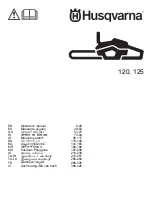
ICFR – Chainsaw Safety and Operating Handbook
24
The felling cut is made parallel to the bottom cut of
the directional notch at either the same level or slightly
above it (never below).
If there is doubt as to the lean of a tree, insert a wedge
in the cut as soon as practicable and drive it home as
the cut proceeds.
The felling cut is taken up until there is an even amount
of hingewood (about 1/10 of the tree’s diameter) left.
The cut must never be taken up to or beyond the
directional notch as the hinge will be eliminated and
there will be no control over the direction of fall.
Once the felling cut has been taken up and the tree
begins to fall:
•
Remove the chainsaw from the cut.
•
Move into the planned escape route. Never stand
directly behind the tree.
•
Watch for falling material.
•
Watch for the tree kicking back or bouncing as it
hits the ground.
Once the tree is on the ground:
•
Ensure that it is stable.
•
Square the butt end, if required.
•
Reduce the stump height, if required.
10.11.2
S
peciAliSed
techniqueS
10.11.2.1 L
arge
trees
with
a
diameter
more
than
the
guide
bar
Length
This technique is suitable where the tree diameter is
up to double the guide bar length.
Use the following procedure:
•
Step 1:
Make the directional notch as for the
standard technique.
•
Step 2:
First insert the chainsaw, leading with
the bottom edge of the guide bar to
avoid kickback.
•
Step 3:
Continue the cut until the right hinge
width is reached. Before making the
swing part of the felling cut, saw back
about the width of the guide bar. That
way the hinge will not be severed.
•
Step 4:
Make the swing cut, being careful not
to saw the hinge on the other side. If
required, use felling aids before the
felling cut is completed. (Refer to
Section 10.11.3).
Figure 14: Diameter up to double the guide bar length
10.11.2.2 L
arge
trees
with
a
diameter
doubLe
the
guide
bar
Length
or
more
This technique is suitable where the tree diameter is
double the guide bar length or more.
Use the following procedure:
•
Step 1:
Make the directional notch as for the
standard technique.
•
Step 2:
Insert the chainsaw in the centre of
the directional notch, leading with the
bottom edge of the guide bar to avoid
kickback.
•
Step 3:
Continue with the insert and swing cut
as in 10.11.2.1 steps 2 to 4, ensuring
that the hinge is thicker than normal
to compensate for the insert cut. Use
felling aids as required.
Figure 15: Diameter double the guide bar length or more
10.11.2.3 s
maLL
trees
that
Lean
the
opposite
way
to
the
feLLing
direction
Sometimes it is difficult to insert a felling lever when
a small tree that leans opposite to the felling direction
needs to be felled. This can be avoided using the
following procedure:
•
Step 1:
Make the directional notch as for the
standard technique.
•
Step 2:
Make one side of the felling cut in the
normal manner and set the felling lever
in the cut. The felling lever must be in
line with the desired felling direction.
•
Step 3:
Make the final part of the felling cut
tilting it down to avoid the felling
















































